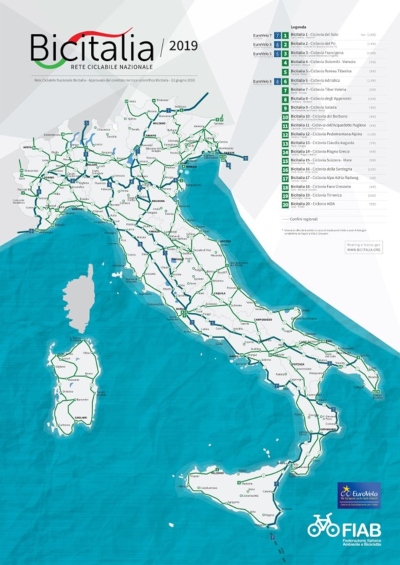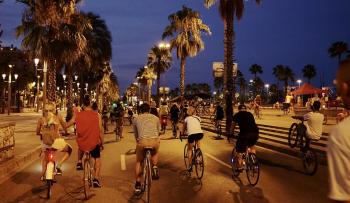
The importance of National Cycling Strategies: Italy implements new General Plan of Cycling Mobility
Persistent efforts and coordination by ECF Member FIAB pay off with the adoption of a cycling plan at the national level. As outlined in our previous report, cohesive government strategy is a vital catalyst to developing more cycling effectively.
In August 2022, the Ministry of Sustainable Infrastructure and Mobility published the General Plan of urban and extra-urban cycling mobility 2022-2024. In line with European recommendations, it aims to improve long-term planning and strengthen urban and interurban cycling mobility systems. The published plan specifies a whole series of objectives including increasing the safety of cyclists, improving signage and creating a shared space between different road users. In addition to this, the aim will be to create new urban and extra-urban cycle paths, also with a focus on cycling tourism.
Italy to invest 1.2 billion euro in cycling
For tourist cycle routes, the National Plan of Recovery and Resilience is set to invest 400 million euro between 2022-2026 to construct 1,235 additional kilometres of cycle paths and carry out necessary maintenance works on the existing network. For urban cycle routes, this fund allocates 200 million euros for the construction of 565 kilometres of routes in urban areas and to strengthen connections between railway stations and universities, by June 2026.
Finally, the guide attached to the Plan, drawn up by a group of experts, including members of the FIAB (Italian Federation of Environment and Bicycle) Study Centre, offers local administrations useful guidelines on the application of the new light tools, such as cycle lanes or stops at traffic lights, for the development of cycling mobility. The General Plan of Urban and Extra-Urban Cycling Mobility 2022-2024 has already assigned loans totally 943 million euros to be invested in cycling, bringing the total value of potential investments to 1.2 billion euro between 2018-2026.
In response to the news, Alessandro Tursi, president of the Federazione Italiana Ambiente e Bicicletta Onlus (FIAB) delivered these warm words congratulating all who had been involved. "We are very proud of the crucial support provided by FIAB during the technical committee of the Ministry of Sustainable Infrastructure and Mobility. FIAB supported the strategy to enhance the level and ambitions of the Plan through a winning and productive collaboration together with other firms and organisations who were attending the committee – thank you very much to all of them. An effective ecological transition cannot exclude the exchange of visions which is a typical trait of mobility – this first General Plan for Cycling Mobility represents the essential tool to move towards this direction [of a sustainable transition].”

Italy’s national cycling network, Bicitalia and the Italian segments of the EuroVelo long-distance cycle network coordinated nationally by ECF Member FIAB.
The recognition of Bicitalia – the national cycle network mapped by FIAB since 2000 – as a cornerstone for the development of the National System of Tourist Cycle Routes has been widely welcomed. But beyond leisure cycling, the document mentions the definition of a specific active mobility program for home-school travel. The adoption of the “Safety in numbers” principle, developed by the European Cyclists' Federation (according to which the increase in the number of bikes in circulation reduces accidents on the roads), aims to improve road safety by increasing cycling and reducing car numbers.

Fewer cars on the roads would result in a lower risk of fatalities for all road users as explained by ECF Senior Policy Officer Ceri Woolsgrove (Source: EU Commission).
Benefits of a national cycling strategy
As per ECF’s recommendations, Italy now joins other countries, such as Spain and more recently the UK, in passing a national cycling strategy. An overview of national cycling strategies across 47 different countries, as well as each country’s individual targets for the share of cyclists and investments, can be found in a recent ECF report from December 2021.
Leading cycling countries, like the Netherlands which has had a cycling strategy since 1990, demonstrate how important such a plan is to develop and grow cycling’s modal share at the national level. Better cohesion between different levels of government working towards a shared national vision can have real positive impact. Generating benefits such as cleaner air, healthier and happier citizens, more liveable cities and towns, better rural connectivity and more vibrant local economies.
National cycling strategies are also instrumental if the world is to cut transport emissions quickly and effectively and avoid the worst of the climate crisis. An unforeseen side-effect of the COVID-19 pandemic was the sudden surge in cycling levels that resulted from national and municipal strategies aimed at re-opening societies after lockdown. Showing that dramatic change is possible with the right level of government support and coordination.
This latest development can be considered a major win for civil society cycling organisations across Europe as yet another national government takes a definitive step in the direction outlined by the ECF 2030 Strategy for more cycling. We congratulate FIAB for the persistent effort in working towards this milestone and we look forward to continuing to support our other member organisations in their own countries as we all work towards securing stronger political support for more and safer cycling for all in Europe.
Read The state of national cycling strategies in Europe (2021) here
Regions:
Contact the author
Recent news!
Upcoming events
Contact Us
Avenue des Arts, 7-8
Postal address: Rue de la Charité, 22
1210 Brussels, Belgium









